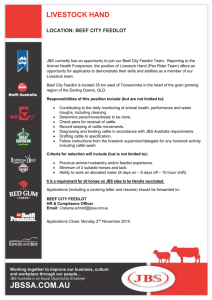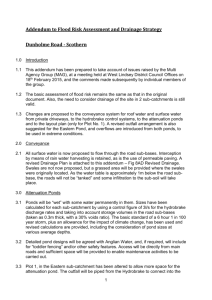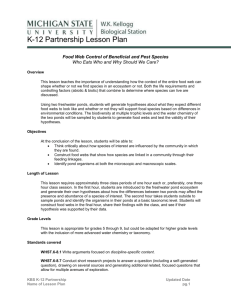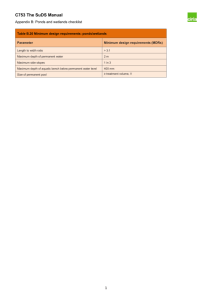Works approval critical information requirements for intensive
advertisement
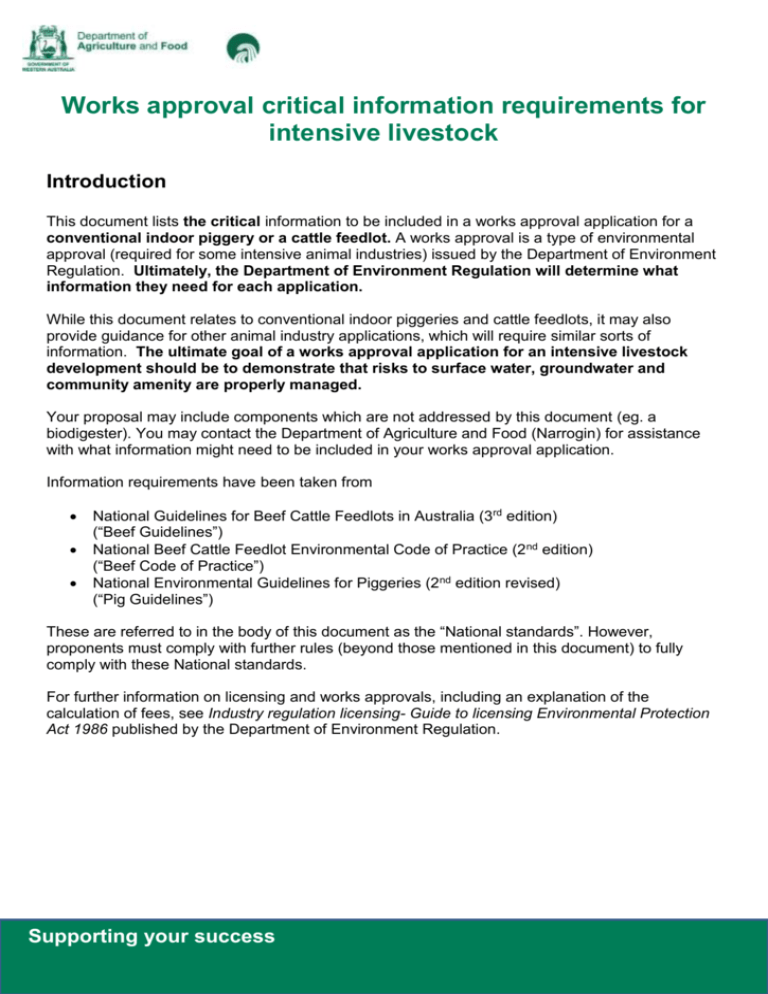
Works approval critical information requirements for intensive livestock Introduction This document lists the critical information to be included in a works approval application for a conventional indoor piggery or a cattle feedlot. A works approval is a type of environmental approval (required for some intensive animal industries) issued by the Department of Environment Regulation. Ultimately, the Department of Environment Regulation will determine what information they need for each application. While this document relates to conventional indoor piggeries and cattle feedlots, it may also provide guidance for other animal industry applications, which will require similar sorts of information. The ultimate goal of a works approval application for an intensive livestock development should be to demonstrate that risks to surface water, groundwater and community amenity are properly managed. Your proposal may include components which are not addressed by this document (eg. a biodigester). You may contact the Department of Agriculture and Food (Narrogin) for assistance with what information might need to be included in your works approval application. Information requirements have been taken from National Guidelines for Beef Cattle Feedlots in Australia (3rd edition) (“Beef Guidelines”) National Beef Cattle Feedlot Environmental Code of Practice (2 nd edition) (“Beef Code of Practice”) National Environmental Guidelines for Piggeries (2nd edition revised) (“Pig Guidelines”) These are referred to in the body of this document as the “National standards”. However, proponents must comply with further rules (beyond those mentioned in this document) to fully comply with these National standards. For further information on licensing and works approvals, including an explanation of the calculation of fees, see Industry regulation licensing- Guide to licensing Environmental Protection Act 1986 published by the Department of Environment Regulation. Supporting your success Contents 1. Contacts and preliminary information 2. Site information 3. Water pollution protection 5. Community amenity protection 6. Contingency plans 7. Diagrams 1. Contacts and preliminary information Name, address, phone number and email of all the parties involved eg. proponent contact, premise owner, premise occupier (if they are different) Premise location using street numbers, lot numbers, diagram or plan numbers or any other information to enable the premises to be clearly identified Overview of development Estimated cost of development Estimated time of completion of development Energy supply Identify your energy requirements and source. Provide details of any relevant permits. Water supply Identify your water requirements and source. Provide details of any relevant permits. Development approvals Identify whether you have made an application for or received development approval from the relevant LGA or other decision making authority. 2. Site information Size of property Existing premises use Size of controlled drainage area This is the area that will need to be managed as part of the development including all areas occupied by infrastructure, including drainage infrastructure. Proximity to environmentally sensitive areas Required clearing of native vegetation Include details of clearing permit if one has been obtained. Site topography o Eg. The proposed feedlot site slopes gently from the south to the north. The fall of the land is approximately 10 m over 400 m or approximately 2.5%. Soil type General soil type information is available via the NRM INFO portal accessible at http://maps.agric.wa.gov.au/nrminfo/ or via the maps and data section of the DAFWA website. o Eg. The dominant soil type at the proposed site is a duplex sand over shallow gravelly clay with medium to heavy clay at depth Groundwater information Provide details about groundwater under your site including o groundwater occurrence type (confined, semi-confined, unconfined), o aquifer type (clay/crystalline rock, silt/fractured rock/limestone or sand/gravel/fill), o salinity level and o distance to groundwater The groundwater occurrence type refers to whether there are water permeable layers above and/or below the aquifer that will transmit water. Aquifer type refers to the substance that the groundwater is contained in. Groundwater information from existing bores may be found on the Department of Water “Water information reporting” atlas at http://wir.water.wa.gov.au/SitePages/SiteExplorer.aspx. 1:250 000 Hydrogeological Series maps showing local aquifers and approximate distances to ground water are also useful. These were published by the Waters and Rivers Commission (now Department of Water) and are available on the Department of Water website by searching the website for “1:250 000 hydrogeology sheets” along with the name of the area you are interested in. Distance to closest surface water Your activity should not be within 50m of a waterway or near a public drinking water source. Flood level The National Standards require that sites are above the 1 in 100 year flood interval level or else incorporate appropriately designed levees or similar structures. Unfortunately, statewide 1 in 100 year flood level data is not available. A more general indication of flood risk could be determined by consideration of local topography or use of the Landgate Flood Map (which gives sites a flood hazard rating according to slope, height, distance from nearest water body and ten year satellite imagery). Topographical maps are available via the NRM INFO portal accessible at http://maps.agric.wa.gov.au/nrminfo/ or via the maps and data section of the DAFWA website. The Landate Flood Map is available on the Landgate website at http://srss.landgate.wa.gov.au/flood. 3. Water pollution protection Mean monthly rainfall data. Data is available via the Bureau of Meteorology website ‘Climate data online’ at http://www.bom.gov.au/climate/data/ . Clean water diversion Describe the clean water sources, drainage and disposal method. o Eg. Clean water is harvested from off roofs and between sheds via diversion banks as shown on attached drawing and directed to a pond for reuse. Waste management system (liquid and solid) Describe your waste management system. You must account for all solid and liquid waste and potentially contaminated water in your system. Eg. (Piggery) Effluent and washing water are removed from the sheds via a pull and plug system into an underground sump before being directed through closed drains to a solids separation screen, into a covered anaerobic treatment pond and then finally into an evaporation pond. Wastewater from truck washdown will also be directed into the same pond system. Solid waste including deceased animals will be composted on a sloped, concrete pad with any leachate draining into the treatment pond via pipes. Eg. (Cattle feedlot) The majority of cow poo will be mechanically scraped out of pens and composted on a concrete pad (with any leachate draining into the treatment ponds) before being taken off site. Effluent (contaminated rainwater from pens) will be directed via drains into a sedimentation pond and then into an evaporation pond. Sludge from the sedimentation pond will be periodically mechanically removed and added to the manure from the pens for composting. Deceased animals will also be composted with the other solids. Design capacity of waste management system (liquid and solid) The design capacity of your waste management system may depend on whether it forms part of your contingency plans (eg. whether you want to include 30 days spare sump capacity to hold waste if there is a pond failure). However, National standards recommend the following design capacities for some parts of the system Continued over page… Potential emission source Liquid waste drains Ponds Cattle feedlot Drains should be sized and maintained so that overtopping occurs no more than once every 20 years National standards suggest ponds should be designed to a capacity so spills occur no more frequently than once in twenty years (or 10 years if effluent is irrigated). National standards recommend cleaning the pond whenever it is dry. Piggery National standards suggest ponds should be designed so overtopping does not occur on average more than once every 10 years. Note: Ponds must also have a 500mm freeboard, which may be sufficient to hold the one in ten year overtopping event. National standards suggest desludging when the volatile solids reduction in the primary anaerobic pond falls below 50% or the volatile solids concentration in the treated effluent exceeds 1%. Solid waste spreading Maximum phosphorus and nitrogen application rate criteria to protect water quality Vulnerability Soil description Max available Max available Maximum category phosphorus (as nitrogen (as N) manure P) loading loading application (kg/ha/yr) (kg/ha/yr) rate (t/ha/yr) (cattle) A Coarse sandy 10 140 1.2 soils/gravels (PRI2<10) draining to surface waters with mod/high risk of eutrophication. B Coarse sandy 20 180 2.6 soils/gravels (PRI<10) draining to waters with low risk of eutrophication. C Loams/clay soils 50 300 6.1 (PRI>10) draining to waters with mod/high risk of eutrophication. D Loams/clay soils 120 480 14.7 (PRI>10) draining to waters with low risk of eutrophication. Source: Waters and Rivers Commission, 1998, Irrigating Vegetated Land with Nutrient-Rich Wastewater (Water Quality Protection Note) as published in Guidelines for the Environmental Management of Beef Cattle Feedlots in Western Australia (2002) o Calculation of solid manure Effluent quantities from piggeries will depend on the inputs into the piggery. The Pigbal program, available from the website of Australian Pork Limited, can be used to calculate the total effluent output. For cattle feedlots, estimated manure production is shown below: Annual manure removed from feedlot pens (Department of Primary Industries and Fisheries Queensland Note 4). Animal weight (kg) Fresh manure Dry matter (t/yr) Manure removed (t/yr) (t/yr) 300 4.27 0.427 0.39 450 6.42 0.642 0.58 600 8.54 0.854 0.78 Source: Reference Manual for the Establishment and Operation of Beef Cattle Feedlots in Queensland (2005), Department of Primary Industries and Fisheries, Queensland o Calculation of treatment pond size The Pigbal program, mentioned above can be used to calculate the size of piggery effluent treatment ponds. While piggery treatment ponds are used to ‘treat’ volatile solids, cattle feedlot ‘treatment’ ponds are used to settle sludge (as a solids separation system). As such, cattle feedlot sedimentation ponds do not need to hold effluent for a long time to ‘treat it’ and can be quite small. In fact, some alternative solids separation systems (weirs, terraces etc) do not hold any water at all. o Calculation of evaporation pond size Permeability of all potential emission sites Describe the permeability of all potential pollution emissions sources. Ideally, all elements of your development will meet the permeability standard specified for that potential emissions site in the relevant National standards (listed below). Potential emission source Pens/Sheds Cattle feedlot Use impermeable liner if the permeability of underlying soil/rock strata exceeds .1mm/day Piggery Sheds should be concreted Carcass composting pads Use impermeable liner if the permeability of underlying soil/rock strata exceeds .1mm/day Pads should have a base permeability no greater than 1 x 10-9 m/s for a depth of 300mm comprising two 150mm deep layers Liquid waste drains A liner able to provide approximately .1mm/d permeability should be used if flow velocity exceeds 1.5 m/s. Drains should be made out of smooth concrete, fibreglass or other impervious material. Ponds National standards suggest ‘holding ponds’ should be underlain by a minimum of 300 mm clay or other suitable compactable soil, or by a synthetic liner able to provide a design permeability of less than .1 mm/d. National standards suggest soil under ponds should have a maximum permeability of 1 x10-9m/s for a depth of 300 mm for ponds up to 2m deep, or a 450 mm for deeper ponds (compacted layers should not exceed 150m each). Ponds constructed with soil contained less than 20% clay will require sealing with liners made from imported clay, polyvinyl chloride or high density polyethylene. All other elements (including solids separation systems, sumps, feedmills, etc) should also be designed to an acceptable permeability standard. Groundwater monitoring procedure 5. Community amenity protection Required distance to sensitive receptors Calculations for separation distances between your activity and the nearest sensitive receptors (S factors) are available in National Standards. If your proposal does not meet the S factor recommendations, you may choose to use a more detailed odour assessment. Descriptions of noise and dust emissions sources, amelioration techniques, monitoring techniques and monitoring frequency. Description of visual impact of site and associated amelioration techniques. 6. Contingency plans Waste management system contingency Power failure contingency Biosecurity event contingency 7. Diagrams Map of premises including o the location and dimensions of the site o the location and dimensions of existing buildings and infrastructure o the location and dimension of proposed building and infrastructure o the location and dimensions of existing features such as vegetation and watercourses o the location of emissions sources and discharge points o the location of environment monitoring activities or equipment (eg. bores) o the location of sensitive receptors o stormwater diversions Annotated aerial maps are ideal. Aerial images are available on Google Earth. Shed/pen plans For a cattle feedlot, common pen designs are back-to-back designs (<2% natural gradient) and front-to-back designs (>2% natural gradient) and include concrete aprons. Diagram of wastewater treatment system including, if applicable, o Flow direction in sheds/pens and drains o Direction of effluent flow between sheds/pens and ponds o Components of the waste treatment system o Capacity, dimensions and design of components of the waste treatment system o Flow points into and out of the waste treatment system o Associated infrastructure such as valves

